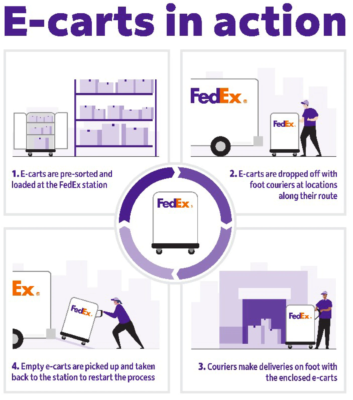Sign up for daily news updates from CleanTechnica on email. Or follow us on Google News!
When I think of GM’s Brightdrop division, the first thing that comes to mind is electric vans. In other words, a van is a van is a van, but some vans use electric instead of gas or diesel, right? But, since Brightdrop was announced, it has proven to be more than just a company selling vans with batteries and motors instead of a gas tank and a combustion engine. Brightdrop has taken the opportunity to do much more, by optimizing the whole delivery process instead of just building the equivalent of Henry Ford’s “faster horse” (even though Ford probably never actually said that).
One way the company is moving the whole delivery experience forward is with electric carts, basically mini-EVs that help delivery workers move a lot more things than they could with a hand truck or manually-pushed cart. The BrightDrop Trace Move cart is specifically designed to streamline last-mile delivery and services. It features smart containerization technology that helps optimize the delivery process. The cart is electrically powered, and assists movement of heavy goods at walking speeds.

By integrating these carts into the delivery process from depot to door, FedEx has been able to use the carts at every step of the process, and they’ve been able to reduce delivery time and human effort needed to load, unload, sort, and then walk the packages the last few yards. In a pilot trial study conducted in Manhattan, the use of e-carts resulted in increased efficiency. The total number of stops and hourly earnings both saw improvements, benefiting customers and reducing congestion on roads.
With the inclusion of routes in the e-cart courier pilot, which now span over seven miles on foot across the two boroughs, FedEx aims to gain valuable insights from operating these units in urban environments. This will assist policymakers in envisioning the future of last-mile delivery in a dynamic urban mobility landscape.
But, there’s no reason that the carts have to be used with a Brightdrop van. As you can probably imagine, this new form of micromobility has potential all by itself. And, GM has been working with grocery stores to see how useful they can be.
Last year, the company made a significant announcement about expanding its business and product portfolio. It introduced a new temperature-controlled eCart that aims to simplify the process of order fulfillment and pickup for online grocery purchases. The online grocery industry is experiencing rapid growth and is projected to reach a market value of $240 billion by 2025. Kroger, the largest grocer in America, is set to become the first customer to incorporate the BrightDrop Trace Grocery into its e-commerce operations, starting this year.
The online order fulfillment process today involves multiple steps within the store to identify, collect, and store products before handing them over to customers. Trace Grocery simplifies this process for grocers by allowing employees to input orders directly into the system and then stationing them curbside for customer pickup. With secure digital verification, Trace Grocery seamlessly integrates with most grocers’ existing online fulfillment apps, providing customers with flexibility when retrieving their purchases.
The Trace Grocery’s unique mobility enables seamless movement within and outside of a store, granting customers access without the need for an employee. This innovative approach empowers grocers to explore novel methods of bringing products closer to the doorsteps of shoppers, opening up new possibilities for convenience and accessibility.
As announced last year, the Trace Grocery offers a range of impressive features:
- Temperature management ensures food-safe storage for up to four hours.
- Propulsion-assistance allows for the effortless movement of up to 350 pounds of groceries, reducing physical strain on the labor force.
- Auto-braking technology stops the electric motor, matching the operator’s walking speed of up to 3 mph.
- With nine compartments, items can be easily organized by order, temperature, and product type, optimizing the pickup process.
- The Trace Grocery is designed for flexibility, enabling seamless maneuverability both inside and outside the grocer’s store, reducing the need for costly staging and infrastructure requirements.
- Weatherproofing capabilities allow the Trace Grocery to handle varying temperatures and outdoor elements with ease.
BrightDrop and Kroger recently completed a successful pilot program in Kentucky, resulting in improved customer and associate experiences. Kroger will now become the first customer of the Trace Grocery, a new addition to BrightDrop’s portfolio of all-electric solutions. BrightDrop has already received over 25,000 EV production reservations and letters of intent, and has delivered over 100 EVs to its launch customer in the largest deployment of commercial electric delivery vans to date. The Trace Grocery is currently available, with full-scale availability expected in 2024 and future customizable capabilities planned.
Now, a year later, Brightdrop is announcing a new feature for these Trace Grocery carts: self dispense.
Self-dispense enables shoppers to collect their online grocery orders directly from secure compartments at a store’s curb, without assistance from store associates. This reduces wait times for customers and improves efficiency for grocers by allowing associates to focus on in-store fulfillment. Manual dispensing of customer orders can consume up to 16% of order fulfillment time. With self-dispense, grocers can eliminate this step entirely, saving time and enabling faster order fulfillment.
How Does It Work?
Step 1 – Pick & Pack: Once an online order is placed with the grocer, a store associate carefully selects and packs the groceries directly into the Trace Grocery compartments, sorting them by temperature into the proper compartments.
Step 2 – Move: After the picking and packing process is complete, a store associate transports the unit to a convenient curbside location for customer pickup. It can keep perishable groceries good for up to four hours.
Step 3 – Serve: The shopper has the option to use their smartphone to unlock specific compartments and retrieve their groceries without the need for assistance from an associate, ensuring a seamless and efficient experience.
GM claims that its trial studies have shown a 34% reduction in time needed to place orders, and that employees are a lot happier now that an electric motor is helping push the load around.
But, I’m a little skeptical of claims that customers are happier with the arrangement. I’d personally rather have someone put the groceries in my car like I do at Walmart currently than need to go pull a cart out and load it myself. But, it’s possible that the carts could be used for deliveries at home in the future, which would be even more convenient.
I’ve reached out to Brightdrop to ask about this aspect of the service, and will update readers when I hear back.
Featured image provided by Brightdrop.
Have a tip for CleanTechnica? Want to advertise? Want to suggest a guest for our CleanTech Talk podcast? Contact us here.
EV Obsession Daily!
I don’t like paywalls. You don’t like paywalls. Who likes paywalls? Here at CleanTechnica, we implemented a limited paywall for a while, but it always felt wrong — and it was always tough to decide what we should put behind there. In theory, your most exclusive and best content goes behind a paywall. But then fewer people read it!! So, we’ve decided to completely nix paywalls here at CleanTechnica. But…
Thank you!
Tesla Sales in 2023, 2024, and 2030
CleanTechnica uses affiliate links. See our policy here.




.jpg)